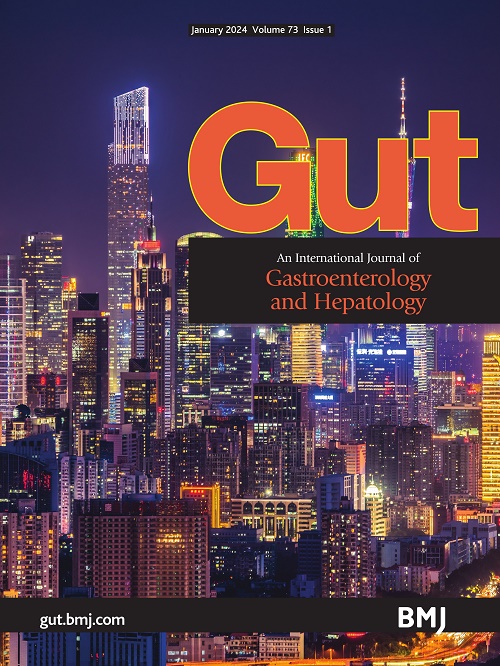Targeting MXD1 sensitises pancreatic cancer to trametinib
IF 25.8
1区 医学
Q1 GASTROENTEROLOGY & HEPATOLOGY
引用次数: 0
Abstract
Background The resistance of pancreatic ductal adenocarcinoma (PDAC) to trametinib therapy limits its clinical use. However, the molecular mechanisms underlying trametinib resistance in PDAC remain unclear. Objective We aimed to illustrate the mechanisms of resistance to trametinib in PDAC and identify trametinib resistance-associated druggable targets, thus improving the treatment efficacy of trametinib-resistant PDAC. Design We established patient-derived xenograft (PDX) models and primary cell lines to conduct functional experiments. We also applied single-cell RNA sequencing, Assay for Transposase-accessible Chromatin with sequencing and Cleavage Under Targets and Tagmentation sequencing to explore the relevant molecular mechanism. Results We have identified a cancer cell subpopulation featured by hyperactivated viral mimicry response in trametinib-resistant PDXs. We have demonstrated that trametinib treatment of PDAC PDXs induces expression of transcription factor MAX dimerisation protein 1 (MXD1), which acts as a cofactor of histone methyltransferase mixed lineage leukaemia 1 to increased H3K4 trimethylation in transposable element (TE) loci, enhancing chromatin accessibility and thus the transcription of TEs. Mechanistically, enhanced transcription of TEs produces excessive double-stranded RNAs, leading to the activation of viral mimicry response and downstream oncogenic interferon-stimulated genes. Inhibiting MXD1 expression can recover the drug vulnerability of trametinib-resistant PDAC cells to trametinib. Conclusions Our study has discovered an important mechanism for trametinib resistance and identified MXD1 as a druggable target in treatment of trametinib-resistant PDAC. Data are available on reasonable request. The raw data of the ATAC-seq and CUT & Tag-seq have been deposited in the Gene Expression Omnibus under accession code GSE253341. The raw data of scRNA-seq and RNA-seq have been deposited in the Genome Sequence Archive in BIG Data Center, Beijing Institute of Genomics, Chinese Academy of Sciences under accession number CRA014564 and HRA009296, respectively. The transcriptomic data and clinical information of the TCGA PAAD cohort and GTEx pancreas cohort were downloaded from the UCSC Xena data portal (靶向MXD1使胰腺癌对曲美替尼敏感
背景 胰腺导管腺癌(PDAC)对曲美替尼治疗的耐药性限制了其临床应用。然而,PDAC对曲美替尼耐药的分子机制仍不清楚。目的 我们旨在阐明PDAC对曲美替尼耐药的机制,并确定与曲美替尼耐药相关的可药靶点,从而提高曲美替尼耐药PDAC的疗效。设计 我们建立了患者衍生异种移植(PDX)模型和原代细胞系来进行功能实验。我们还应用了单细胞RNA测序、转座酶可接触染色质测序和靶标下裂解及标记测序来探索相关的分子机制。结果 我们在曲美替尼耐药的 PDXs 中发现了一个以超活化病毒模拟反应为特征的癌细胞亚群。我们已经证明,曲美替尼治疗 PDAC PDXs 会诱导转录因子 MAX 二聚化蛋白 1(MXD1)的表达,MXD1 作为组蛋白甲基转移酶混系白血病 1 的辅助因子,会增加转座元件(TE)位点的 H3K4 三甲基化,提高染色质的可及性,从而增强转座元件的转录。从机理上讲,TE 的转录增强会产生过量的双链 RNA,导致病毒模仿反应和下游致癌干扰素刺激基因的激活。抑制 MXD1 的表达可使曲美替尼耐药的 PDAC 细胞恢复对曲美替尼的药物易感性。结论 我们的研究发现了曲美替尼耐药的重要机制,并确定了 MXD1 是治疗曲美替尼耐药 PDAC 的药物靶点。如有合理要求,可提供相关数据。ATAC-seq和CUT & Tag-seq的原始数据已存入基因表达总库,加入代码为GSE253341。scRNA-seq和RNA-seq的原始数据已存入中国科学院北京基因组研究所BIG数据中心的基因组序列档案,登录号分别为CRA014564和HRA009296。TCGA PAAD队列和GTEx胰腺队列的转录组数据和临床信息从UCSC Xena数据门户网站()下载。基因边界使用 GENCODE 注释定义,重复边界使用从 Hammell 实验室网站获得的 GTF 文件定义(下载地址:[https://labshare.cshl.edu/shares/mhammelllab/www-data/TEtranscripts/TE\_GTF/GRCh38\_GENCODE\_rmsk\_TE.gtf.gz][1])。用于生成本研究数据的所有自定义代码均可在合理要求下提供。[1]: https://labshare.cshl.edu/shares/mhammelllab/www-data/TEtranscripts/TE_GTF/GRCh38_GENCODE_rmsk_TE.gtf.gz
本文章由计算机程序翻译,如有差异,请以英文原文为准。
求助全文
约1分钟内获得全文
求助全文
来源期刊

Gut
医学-胃肠肝病学
CiteScore
45.70
自引率
2.40%
发文量
284
审稿时长
1.5 months
期刊介绍:
Gut is a renowned international journal specializing in gastroenterology and hepatology, known for its high-quality clinical research covering the alimentary tract, liver, biliary tree, and pancreas. It offers authoritative and current coverage across all aspects of gastroenterology and hepatology, featuring articles on emerging disease mechanisms and innovative diagnostic and therapeutic approaches authored by leading experts.
As the flagship journal of BMJ's gastroenterology portfolio, Gut is accompanied by two companion journals: Frontline Gastroenterology, focusing on education and practice-oriented papers, and BMJ Open Gastroenterology for open access original research.
 求助内容:
求助内容: 应助结果提醒方式:
应助结果提醒方式:


